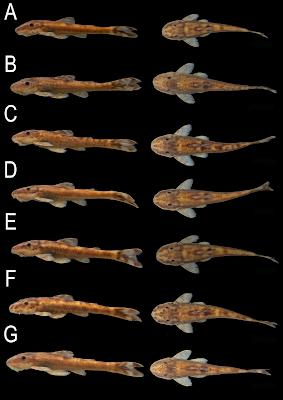 |
| Parotocinclus nandae
Lehmann A., Camelier & Zanata, 2020
|
Abstract
A new species of Parotocinclus from the upper Rio Paraguaçu, Bahia, Brazil, is described. The new species is distinguished from all congeners by its unique color pattern, with irregular dark blotches resulting in a somewhat marble-spotted pattern on head and trunk of most specimens and dorsum of head with a conspicuous V-shaped light mark from tip of snout to nares. The new species is also distinguished from congeners by having the lower lip elongated posteriorly and reaching or surpassing the anterior margin of cleithrum on the pectoral girdle, the canal cheek plate on the ventral surface of the head reduced and with a slightly concave margin, and abdomen covered by small embedded platelets, without contact with each other and not arranged in a line between the pectoral-fin axilla and pelvic-fin origin. The presence of a thick and rough skin in the interradial membrane of pelvic fin exclusively in the females of P. nandae is reported by the first time to occurs in Siluriformes.
 |
| Fig 1. Parotocinclus nandae, holotype. MCP 54184, 39.8 mm SL, male; Brazil, Bahia, Ibicoara, upper Rio Paraguaçu, under bridge on highway BA-142, between Ibicoara and Barra da Estiva, ... |
Parotocinclus nandae sp. nov.
Diagnosis: The new species is distinguished from all congeners by its unique color pattern, with irregular dark blotches resulting in a somewhat marble-spotted pattern on head and trunk, and dorsum of head with a conspicuous pale V-shaped mark extending from tip of snout to, or slightly posterior of, nares (Fig 1). Parotocinclus nandae can be further diagnosed from its congeners by having the lower lip elongated posteriorly, longer than wide, and reaching to or surpassing the anterior margin of cleithrum (vs. lower lip not elongated, wider than longer, and falling distinctly short of pectoral girdle); canal cheek plate on the ventral surface of the head not expanded mesially or posteriorly, with a slightly concave margin (vs. canal cheek plate expanded mesially or posteriorly, with triangular tip) (Fig 2); and abdomen covered by small embedded platelets not in contact with each other and not aligned between pectoral- and pelvic-fin origins (vs. abdomen completely lacking plates or covered with plates usually contacting each other and arranged in transverse lines).
 |
| Fig 6. Color in life of Parotocinclus nandae in left lateral view. UFBA 6976, paratype, 40.7 mm SL, Brazil, Bahia, Ibicoara, upper Rio Paraguaçu basin, ... |
 |
| Fig 8. Type locality of Parotocinclus nandae. Brazil, Bahia State, Ibicoara, upper Rio Paraguaçu. |
Geographic distribution: Parotocinclus nandae is known from two localities in the upper portion of the Rio Paraguaçu basin, Chapada Diamantina domain, Bahia State, Brazil (Fig 7).
Etymology: The specific name nandae honors Maria Fernanda Boaz Lehmann, daughter of the first author of this paper and affectionately known as “Nanda”. A noun in genitive.
Pablo Lehmann A., Priscila Camelier and Angela Zanata. 2020. Parotocinclus nandae, A New distinctive colored Catfish (Loricariidae: Hypoptopomatinae) from the upper Rio Paraguaçu, Bahia State, northeastern Brazil. PLoS ONE. 15(7): e0236690. DOI: 10.1371/journal.pone.0236690




